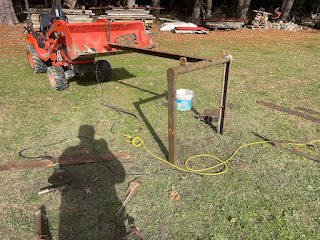I decided a DIY Log Arch might be handy for hauling logs and firewood from places it would be hard getting a regular trailer to. It would also help keep logs heading to the sawmill much cleaner. So I started scrounging and found this old three point hitch back blade that I would likely never use.
A DIY Log Arch can be used to haul logs and keep them clean, or haul any logs and trees out for firewood, lumber or just clean up with minimal mess. It allows hauling large logs with a vehicle like a ATV, side by side, 4 wheeler or a tractor smaller than would normally be used. It can keep the logs completely off the ground when moving, or just elevate one end. Either way makes for cleaner and easier moving.
The goal was to use as much recycled materials as I could find.
A bit of cutting and design to see what pieces fit best for where and/or what.
The main center beam is 8′ long. I left the rear frame as long as it was in the back blade, (which will will see later was shorten) I wasn’t sure exactly how long it should be. It’s 36″ by about 36″
I found an old house trailer axle I decided to use.
I had thoughts of using the smaller axle in the next image, but decided against it.
I found a couple old 15″ Ford or Jeep rims probably form the 1970’s. I’ll mount a couple used tires and we’ll be off to the races.
Note the bolts have been cut off to allow for a normal wheel to be attached. The inside pins are the exact pattern for the wheels I had, so I drilled them out and the wheels are attached to the hub with 5 – 1/2″ bolts acting as lug nuts.
Note on this first test run I used a come-a-long. I did not have a winch yet and I wanted to try it out. The come-a-long worked fine, it is just obviously a little slower than a winch.
The first attempt was a complete success.It handled the log easily and backed right up on the trailer. I will say i really wish my 4 wheeler had power steering though.
This is the second run. I had planned to cut this in half but decided to see if I could haul it. (OK, i forgot the screw gun so I couldn’t attach the ladder and use the Alaskan mill and I did not want to free hand this log) This is roughly 9′ of green red oak. I estimate it to be a little over 2100 pounds. I’m not sure I like this configuration with the pipes along the side, the pipes used for cross support may be to close together towards the front. I may need to figure a way to widen them a little. I am going to use it to see. Keeping the front of the log lower may have some advantages when raising the back. We shall see.
On this run, the weight of the one ton plus log bent the frame slightly. I believe this was due to where I was dragging it from. Coming Across the hayfield it was rough and hilly. I had to go a little faster with the 4wheeler to maintain traction to get over some of the hills. I’m sure the pounding contributed to the issue.
So I’ll fix this by shortening the frame. It was actually longer than it should have been anyhow. Shortening it will double the frame member in the weakest spot, shorten the leverage against the frame and lower the center of gravity.
I also added these U bolts. I don’t see this on any other builds, but the possibility of a cable break seems like a little precaution is in order. Should the cable snap, these are between me and the way back. I also plan to eventually make it so I can haul smaller stuff on top. This will keep that off the cable.
This is after the cut and reweld to shorten the rear frame and fix the bend. This should definitely make it stronger.
A 2″ ball coupler as planned was added to the DIY Log Arch
I’ve added a winch
Final dimensions: Main frame length is 8′. Minimum distance between inside the wheels is 26″. From ground to inside top is 46″
























































